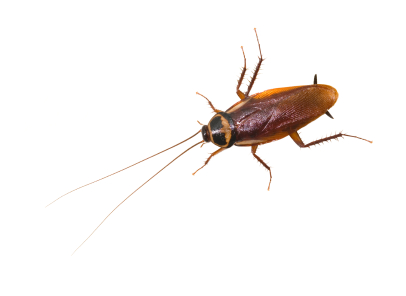Biology and Life Habits

There are five different species of cockroaches that can be found in Canada. Reliable offers cockroach control and extermination service in towns of Toronto, Oakville, Pickering, Mississauga and Whitby.
Two cockroach species are about 15mm (3/4”) in size and have a flattened oval shaped body with spindly legs. These so called small cockroaches are the German and Brown-banded cockroach. Both males and females are winged but only the Brown-banded cockroach can fly.
The German cockroach, the most common species, carries an egg purse that holds at least 40 eggs which develop into reproductive adults in three months. A single fertile female lives about one year and can produce thousands of cockroaches within one year’s time.
The three large species of cockroaches, 20mm to 40mm (1” to 2”) in size, are the Oriental, American and Common Wood cockroach. The Oriental and American are usually in basement areas, steam tunnels or sewage pits and tunnels, while the Common Wood cockroach can be found outside in leaf litter and under bark chips.
For all species of cockroaches almost anything is a food source, paper, cloth, plants, etc. Cockroaches have been associated with the transmission of Salmonella bacteria, the organisms responsible for food poisoning.
Questions and Answers
Q – What attracts cockroaches?
A – Cockroaches are attracted to food, water, warmth, and shelter. They will eat anything and are particularly attracted to starchy foodstuffs.
Q – When are cockroaches most common?
A – Cockroaches are active year-round.
Q – When am I most likely to see cockroaches?
A – Cockroaches are nocturnal and are most active at night. Any sudden light will cause them to scurry for shelter.
Q – Are cockroaches only found under unclean conditions?
A – No. They can be found under the cleanest conditions, whenever food and warmth are present. For this reason they are a major problem in hospitals, hotels, restaurants, bakeries, butcher shops, multi-unit residences and homes. Their habitat is around sinks, behind stoves and refrigerators, in drains and cracks.
Q – Do cockroaches cause damage?
A – No. The presence of cockroaches is not normally associated with damage to buildings or vegetation.
Q – Are cockroaches hazardous to humans?
A – Yes, Cockroaches are second only to house flies in spreading disease. Because of their movements through various habitats, including refuse heaps and sewers, they are capable of transmitting disease to man, including salmonella bacteria (food poisoning), polio and many forms of viruses.
Q – Do cockroaches die off in the cold months?
A – No. These are hardy and very adaptable insects are primarily Indoor pests and infestations are not affected by temperature.
Q – Can I do anything to prevent a cockroach infestation?
A – Although little can be done to prevent an infestation, the Practice of good sanitation and the elimination of accessible food are ways to minimize the extent of the infestation. Careful inspection of produce or packages entering the building can help prevent cockroaches from establishing themselves in your building.
Preparation Guidelines for a Cockroach Treatment
1. Clear cupboards beneath the sink in the kitchen and bathroom.
2. Remove cutlery from drawers.
3. Clean off kitchen counter.
4. Pull refrigerator and stove away from wall if possible.
5. In bedrooms, remove any shoes, boxes etc. from the floor of the closet.
6. Ensure objects such as toys, papers and all personal belongings are off the floor so that the technician can get around all rooms.
7. Vacate the premises during service and do not re-enter until at least 4 hours after treatment.
8. Upon return, do not wash the shelves.
9. Place shelf paper on them before replacing food and utensils.
10. Do not be alarmed if you see a few cockroaches after treatment has been completed.
11. Activity should subside within a week or two.
If you have any questions after the service, please call our office.
